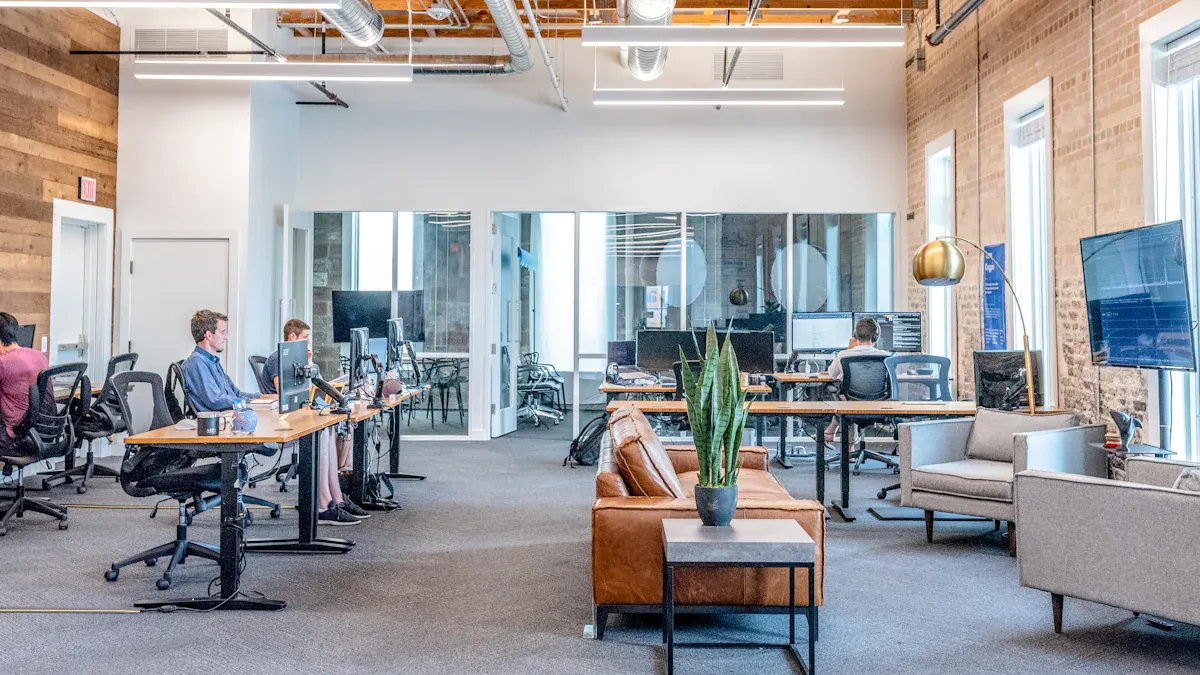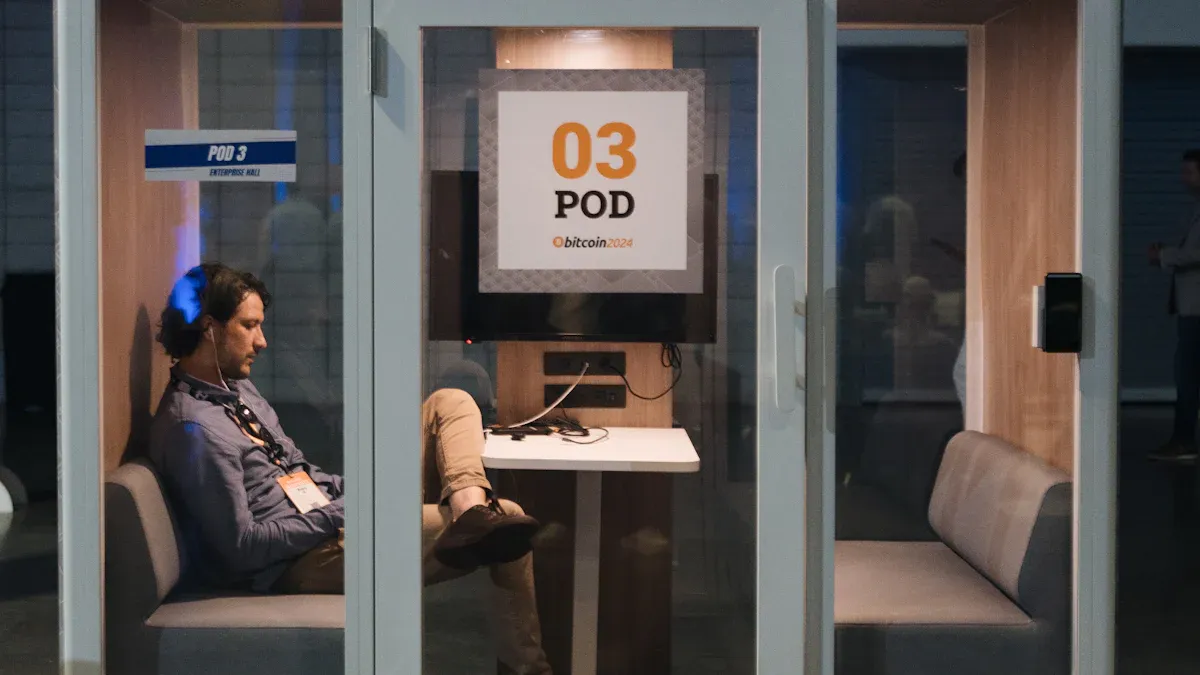
Rest is no longer a luxury in today’s fast-paced work environments; it’s a necessity. Companies now understand that tired employees can’t perform at their best. Studies show that sleep deficits increase the risk of accidents and reduce mental alertness. To combat this, businesses are turning to innovative solutions like workplace nap pods, meeting pods office configurations, office phone booths, and private office pods. But how did these modern tools become essential in office culture?
Historical Roots of Workplace Nap Pods

Napping Traditions in Ancient Cultures
Napping has been a part of human history for centuries. Ancient cultures like Greece and Rome placed great importance on sleep. In Greek mythology, Hypnos represented sleep, while the Romans had Somnus. These figures symbolized the restorative power of rest. Philosophers and poets from these eras often wrote about the benefits of napping. Archaeological discoveries also reveal how people in these societies arranged their spaces to prioritize rest. These traditions highlight how deeply ingrained napping was in daily life, setting the stage for modern innovations like workplace nap pods.
Capsule Hotels and Early Nap Pod Innovations
The idea of compact spaces for rest began in Japan with capsule hotels. The Nakagin Capsule Tower, built in 1972, introduced modular spaces for sleeping. Later, in 1979, the Capsule Inn in Osaka designed the first “Sleep Pods.” These innovations reflected Japan’s cultural acceptance of public napping, known as Inemuri. This concept inspired the design of modern nap pods. By the early 2000s, workplaces started adopting these pods, recognizing the productivity boost short naps could provide. The evolution of capsule hotels directly influenced the development of workplace nap pods.
The Concept of Power Naps and Workplace Integration
The term “Power Nap” became popular in 1998, thanks to psychologist James Maas. Research soon supported the idea that short naps could improve performance. For example:
- A 26-minute nap increased alertness by 54% and performance by 34%.
- Naps lasting 60-90 minutes enhanced memory and learning.
- A one-hour nap boosted productivity for up to ten hours.
These findings encouraged companies to integrate nap pods into offices, creating spaces where employees could recharge and perform at their best.
The Rise and Impact of Workplace Nap Pods
Adoption by the Tech Industry
Tech companies have always been ahead of the curve when it comes to workplace innovation. They were among the first to embrace nap pods as part of their office designs. This trend reflects a broader strategy to improve employee health and productivity. By offering spaces for rest, these companies reduce absenteeism and turnover. Employees feel valued, which boosts morale and engagement. Nap pods are no longer seen as a luxury but as a smart investment in the workforce.
Scientific Insights on Sleep and Productivity
Science backs up the benefits of short naps. NASA’s research shows that a brief nap can improve alertness by 54% and task performance by 34%. Other studies highlight how naps reduce stress and enhance mood. Companies that introduce nap pods notice significant changes in employee behavior. For example, EnergyPods have transformed break habits. Before their introduction, only 37% of staff took 30-minute breaks. Afterward, this number jumped to 69%. Employees also reported feeling more alert (81%) and energized (84%) after using the pods.
| Metric | Before EnergyPods | After EnergyPods | Change |
|---|---|---|---|
| Percentage of staff taking 30-minute breaks | 37% | 69% | +32% |
| Percentage feeling more alert after use | N/A | 81% | N/A |
| Percentage feeling more energized after use | N/A | 84% | N/A |
| Percentage feeling more able to drive | N/A | 50% | N/A |
Benefits for Employee Wellness and Mental Health
Nap pods do more than boost productivity—they improve wellness and mental health. The British NHS found that introducing EnergyPods significantly increased staff wellbeing and engagement. Short naps also reduce stress levels and improve mood, according to general research. Employees who feel rested are more likely to stay motivated and focused. Nap pods create a healthier work environment, where mental health is prioritized alongside performance.
| Study/Source | Findings | Metrics |
|---|---|---|
| British NHS | Significant increases in staff wellbeing and engagement after EnergyPods introduction | Improved wellbeing and engagement |
| NASA Study | Brief naps improve alertness by 54% and task performance by 34% | Alertness and performance metrics |
| General Research | Short naps reduce stress levels and improve mood | Stress reduction and mood improvement |
Innovations and Future Trends in Workplace Nap Pods

Advances in Nap Pod Technology
The world of nap pods is evolving rapidly. Companies are pushing boundaries with cutting-edge designs and features. Modern nap pods now include smart sensors that monitor sleep patterns and adjust lighting or sound to enhance relaxation. Some even offer aromatherapy or temperature control for a personalized experience. These advancements aim to create the perfect environment for short, restorative naps.
The nap pod market is also growing at an impressive rate. In 2023, it was valued at USD 725.19 million and is projected to reach USD 1,848.18 million by 2032. This growth reflects the increasing demand for innovative solutions that prioritize employee wellness. With a compound annual growth rate (CAGR) of 11.1% from 2024 to 2032, the future of nap pod technology looks promising.
Wellness-Centric Office Designs
Workplaces are shifting toward designs that prioritize employee health and happiness. Many companies now include dedicated napping spaces, such as nap rooms or wellness pods, in their office layouts. This trend highlights a growing recognition of the role rest plays in maintaining a productive workforce.
These changes mark a departure from traditional work cultures that valued constant busyness. By integrating nap pods into wellness-centric designs, companies create environments where employees feel supported and valued. This approach not only boosts morale but also enhances overall workplace efficiency.
Predictions for the Future of Workplace Nap Pods
The future of workplace nap pods is bright. As awareness of the health benefits of short naps grows, more industries are expected to adopt these innovative solutions. The competitive nap pod market will likely see new players introducing creative designs and features.
Experts predict that nap pods will become a standard feature in modern offices. They may also integrate with other wellness technologies, such as fitness trackers or mental health apps, to provide a holistic approach to employee well-being. These advancements will continue to shape the way companies view rest and productivity.
Workplace nap pods have come a long way, evolving from ancient napping traditions to modern office essentials. Research shows that short naps can boost alertness by 54% and task performance by 34%. Companies now embrace these pods to reduce stress, improve mood, and foster a healthier work culture. With advancements in technology and growing demand, nap pods are set to redefine how workplaces prioritize wellness and productivity.
📊 Did you know? The global nap pod market is projected to grow from USD 2.3 billion in 2024 to USD 4.8 billion by 2033, with an annual growth rate of 8.18%.
FAQ
What are nap pods, and how do they work?
Nap pods are compact, private spaces designed for short naps. They often feature reclining seats, calming lights, and soundproofing to create a restful environment.
Are nap pods suitable for all workplaces?
Yes, nap pods fit most workplaces. They’re especially useful in high-stress industries like tech, healthcare, and finance, where employee wellness directly impacts performance.
How long should a nap in a nap pod last?
Experts recommend naps of 20-30 minutes. This duration boosts alertness and energy without causing grogginess, making it ideal for work breaks.
💡 Tip: Encourage employees to use nap pods during lunch breaks for maximum productivity throughout the day.

